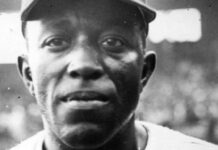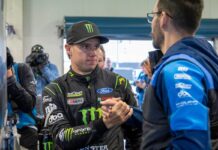
The race itself will stay with a simplified format – two heat races to set the All-Star Race starting lineup, a 100-lap All-Star Open, and a 200-lap main event at the historic .625-mile track that pays $1 million to the winner.
However, several new features will debut including a tire strategy element, a new qualifying/pit crew challenge format and pitting requirements.
Potentially, three different tires will be utilized throughout the weekend— a “prime tire” (the baseline tire assessed in last month’s Goodyear tire test), an “option tire” (slick tires but made with the same rubber as the wet weather tire) and “wet weather” (the wet weather tire only used if the track is wet).
The ‘Goodyear Eagle’ lettering will be yellow on the prime tires, red on the option tires, and white on the wet weather tires.
The particulars on the tires:
– Teams will be allotted nine sets of tires for the event weekend.
– For practice, qualifying, the heat races, and the Open, teams will be allotted three sets of prime tires and two sets of option tires.
– For the All-Star Race, teams will have two sets each of primes and options.
– All four tires on the car must be of the same type at all times.
– Only the prime tire will be used during both qualifying sessions.
– For practice, the heat races, and the All-Star Open, teams will have the option to start on any type of tire.
– All teams will start on the option tire for the All-Star Race main event.
“After a successful return to North Wilkesboro Speedway last season, we are thrilled to bring the action back to one of NASCAR’s most iconic and storied tracks,” said John Probst, NASCAR Senior Vice President and Chief Racing Development Officer.
“The spotlight will certainly be on the crew chiefs and drivers as they plan their tire strategy for this special race. In testing, the softer tires were significantly faster but wore much quicker. Goodyear has been an incredible partner in this All-Star element, and it will be fascinating to watch how crew chiefs and drivers manage this unique challenge.”
Race length and eligibility
The All-Star Race will be 200 laps with two ‘All-Star’ cautions at lap 100, and lap 150. At the lap 100 break, teams must perform a four-tire pit stop, using any tire of their choosing. All laps (caution and green flag) will count, and NASCAR overtime rules will be in effect.
Saturday’s All-Star 100-lap Open will have an ‘All-Star’ caution at Lap 50, at which time teams must perform a four-tire pit stop. At the end, three Open drivers will advance to the main event – the top two race finishers and the fan vote winner. Fan voting is now open on NASCAR.com/fanvote.
All-Star weekend festivities will begin Friday with qualifying and the pit crew challenge. While last season’s qualifying was based solely on the results of the pit crew challenge, this season will include the traditional qualifying effort.
Drivers will take the green flag, run one full lap at speed, and on the second lap proceed to one of two NASCAR designated pit stalls for a four-tire stop with mock fuel delivery. When the pit stop is complete, the cars will exit pit road and race back to the checkered flag.
The qualifying time will be the total elapsed time from green flag to checkered flag, and the pole sitter will start on the pole for Heat Race 1 and the All-Star main event.
The pit crew with the fastest stop during the All-Star qualifying attempt (no penalties) is the winner of the challenge. Pit crew challenge results will determine pit picking order.
There are currently 18 drivers already locked into the main event: A.J. Allmendinger, Christopher Bell, Ryan Blaney, Chris Buescher, Kyle Busch, William Byron, Ross Chastain, Chase Elliott, Denny Hamlin, Brad Keselowski, Kyle Larson, Joey Logano, Michael McDowell, Tyler Reddick, Ricky Stenhouse Jr., Daniel Suárez, Martin Truex Jr., and Shane van Gisbergen.













































